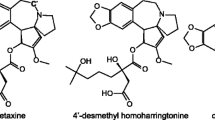Summary
The activated metabolites of ifosfamide and cyclophosphamide (4-hydroxy-ifosfamide and 4-hydroxy-cyclophosphamide) were analysed fluorometrically by condensation of liberated acrolein with m-aminophenol yielding 7-hydroxychinolin. Interfering fluorescence of blood and urine was eliminated by extraction with dichlormethane and determination of blanks in which the liberated acrolein reacted with hydrazine to non-fluorescent pyrazoline. The modified test proved effective in identifying low levels of activated metabolites in man. After i.v. injection of 20 mg/kg cyclophosphamide or ifosfamide peak levels of activated cyclophosphamide (4.7 nmol/ml) and the area under the curve (c·t=16.7 nmol·ml/h) showed mean values three times higher than those found for activated ifosfamide.
One per cent of the applied dosis of cyclophosphamide vs. 0.3% of ifosfamide was excreted as activated metabolites. Due to the high stability of activated cyclophosphamide and ifosfamide in urine a low liberation rate of acrolein was found, the concentration of which in urine was below 0.5 nmol/ml. Acrolein, which was directly liberated from activated cyclophosphamide or ifosfamide, does not seem to play an important role in the urotoxicity of these cytostatics.
Similar content being viewed by others
References
Alarcon RA (1968) Fluorometric determination of acrolein and related compounds with m-aminophenol. Anal Chem 40:1704–1708
Allen LM, Creaven PJ, Nelson RL (1976) Studies on the human pharmacokinetics of isophosphamide (NSC-109724). Cancer Treatm Rep 60:451–458
Brock N (1976) Comparative pharmacologic study in vitro and in vivo with cyclophosphamide (NSC-26271), cyclophosphamide metabolites, and plain nitrogen mustard compounds. Cancer Treatm Rep 60:301–308
Brock N, Hohorst HJ (1977) The problem of specificity and selectivity of alkylating cytostatics: studies on N-2-chloro-ethylamido-oxazaphosphorines. Z Krebsforsch 88:185–215
Brock N, Stekar J, Pohl J, Niemyer U, Scheffler G (1979) Acrolein, the causative factor of urotoxic side-effects of cyclophosphamide, ifosfamide, trofosfamide, and sufosfamide. Arzneim Forsch 29:659–661
Cox PJ (1979) Cyclophosphamide cystitis, identification of acrolein as the causative agent. Biochem Pharmac 28:2045–2049
Creaven PJ, Allen LM, Cohen MH, Nelson RL (1976) Studies on the clinical pharmacology and toxicology of isophosphamide (NSC-109724). Cancer Treatm Rep 60:445–449
Dräger U, Peter G, Hohorst HJ (1976) Deactivation of cyclophosphamide (NSC-26271) metabolites by sulfhydryl compounds. Cancer Treatm Rep 60:355–359
Däger U, Hohorst HJ (1976) Permeation of cyclophosphamide (NSC-26271) metabolites into tumor cells. Cancer Treatm Rep 60:432–427
Fenselau C, Kan MNN, Rao SS, Myles A, Friedman OM, Colvin M (1977) Identification of aldophosphamide as a metabolite of cyclophosphamide in vitro and in vivo in humans. Cancer Res 37:2538–2543
Friedman OM, Myles A, Colvin M (1979) Cyclophosphamide and related phosphoramid mustards. Advances in Cancer Chemotherapy. A. Rosowsky, Boston (Mass)
Hohorst HJ, Peter G, Struck RF (1976 a) 4-Hydroperoxy Derivatives of ifosfamide and trofosfamide: Synthesis by direct ozonation and antitumor evaluation in vivo. Cancer Res 36:2278–2283
Hohorst HJ, Dräger U, Peter G, Voelcker G (1976 b) The problem of oncostatic specificity of cyclophosphamide (NSC-26271): Studies on reactions that control the alkylating and cytotoxic activity. Cancer Treatm Rep 60:309–315
Mellet JB, El Dareer SM, Luce JK, Frei E (1969) III. Activation and cyclophosphamide metabolism in various species. Pharmacologist 11:273
Norpoth K, Müller G, Raidt H (1976a) Isolierung und Charakterisierung zweier Hauptmetabolite von Ifosfamid aus Patientenurin. Arzneim Forsch 25:1376–1377
Norpoth K (1976b) Studies on the metabolism of isophosphamide (NSC-109724) in man. Cancer Treatm Rep 60:437–443
Peter G, Wagner T, Hohorst HJ (1976) Studies on 4-hydroperoxy-cyclophosphamide (NSC-181815): A simple preparation method and its application for the synthesis of a new class of “activated” sulfur-containing cyclophosphamide (NSC-26271) derivatives. Cancer Treatm Rep 60:429–435
Przybylski M, Ringsdorf H, Lenssen U, Peter G, Volecker G, Wagner T, Hohorst HJ (1977) Mass spectrometric characterization of activated N-(2-chloroethyl)amido oxazaphosphorine derivatives. Biomed Mass Spectrom 4:209–215
Sachs L (1969) Statistische Auswertungsmethoden, 2. Aufl. Springer, Berlin Heidelberg New York, S 293–300
Schaumlöffel E (1977) Vortrag, Internationales Holoxan-Symposion Düsseldorf (22.03.1977)
Sladek NE (1973) Bioassay and relative cytotoxic potency of cyclophosphamide metabolites generated in vitro and in vivo. Cancer Res 33:1150–1158
Struck RF, Kirk MC, Witt MH, Laster WR Jr (1975) Isolation and mass spectral identification of blood metabolites of cyclophosphamide: Evidence for phosphoramide mustard as the biologically active metabolite. Biomed Mass Spectrom 2:46–52
Voelcker G, Dräger U, Peter G, Hohorst HJ (1974) Studien zum Spontanzerfall von 4-Hydroxycyclophosphamid und 4-Hydroperoxycyclophosphamid mit Hilfe der Dünnschichtchromatographie. Arzneim Forsch 24:1172–1176
Voelcker G, Haeglsperger R, Hohorst HJ (1979) Fluorometrische Bestimmung von “aktiviertem” Cyclophosphamid und Ifosfamid im Blut. J Cancer Res Clin Oncol 93:233–240
Wagner T, Peter G, Voelcker G, Hohorst HJ (1977) Characterization and quantitative estimation of activated cyclophosphamide in blood and urine. Cancer Res 37:2592–2596
Wagner T, Heydrich D, Voelcker G, Hohorst HJ (1980) Über Blutspiegel und Urinausscheidung von aktiviertem Cyclophosphamid und seinen Deaktivierungsprodukten beim Menschen. J Cancer Res Clin Oncol 96:79–92
Author information
Authors and Affiliations
Additional information
Dedicated to Professor U. Ritter on his 60th birthday
With the support of the Bundesministerium für Forschung und Technologie, Bonn
Rights and permissions
About this article
Cite this article
Wagner, T., Heydrich, D., Jork, T. et al. Comparative study on human pharmacokinetics of activated ifosfamide and cyclophosphamide by a modified fluorometric test. J Cancer Res Clin Oncol 100, 95–104 (1981). https://doi.org/10.1007/BF00405906
Received:
Accepted:
Issue Date:
DOI: https://doi.org/10.1007/BF00405906




